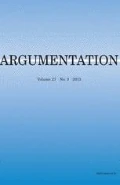Abstract
An important issue for visual argumentation is its relationship to propositions, since it has been argued that, in order to be arguments, images should be propositional. The first part of the paper will approach this debate from a theoretical perspective. After quickly surveying the field on the issue, I will address the relationship between images and propositions. Three specific questions will be examined: (a) can propositions accurately account for the way images express arguments?; (b) are verbal propositions necessary to reconstruct arguments that images alone cannot convey, due to their lacking linguistic tools?; (c) are images essentially non-propositional because they don’t have truth-value? The second part of the paper will include a detailed analysis of two posters. From these analyses, I will ultimately conclude that some images can display a visual argument without necessarily being propositional.


Similar content being viewed by others
Notes
It should be noted that not all propositional logics distinguish between sentence and proposition. In the chapter Govier devotes to propositional logic, no difference is made between proposition and statement (Govier 2001, p. 253), since, for her, the logical relationship between statements is the only one that counts.
This is not exactly what Stainton says, since his thinking remains a propositional one. But this is a consequence that can be drawn from his claim.
Statement kindly communicated to me by the artist (and quoted here partially) in an email from July 25, 2013. It is reproduced in part in Glaser and Ilic 2006, p. 85.
References
Arnheim, Rudolf. 1969. Visual thinking. Berkeley: University of California Press.
Baratin, Marc, et al. 2004. Proposition. In Vocabulaire européen des philosophies, ed. B. Cassin, 1031–1047. Paris: Seuil.
Barceló Aspeitia, Axelo. 2012. Words and images in argumentation. Argumentation 26(3): 355–368.
Benveniste, Émile. 1974. Problèmes de linguistique générale. II. Paris: Gallimard.
Bermúdez, José Luis. 2003. Thinking without words. Oxford: Oxford University Press.
Blair, Anthony J. 1996. The possibility and actuality of visual arguments. Argumentation and Advocacy 33(1): 23–39.
Blair, Anthony J. 2004. The rhetoric of visual arguments. In Defining visual rhetorics, ed. Charles A. Hill, and Marguerite Helmers, 41–61. Mahwah, NJ: Lawrence Erlbaum.
Carel, Marion. 2011. L’Entrelacement argumentatif: Lexique, discours et blocs sémantiques. Paris: Honoré Champion.
Copi, Irving M., and Carl Cohen. 2002. Introduction to logic, 11th ed. Upper Saddle River, NJ: Prentice Hall.
Eco, Umberto. 1968. La struttura assente. Milano: Casa Ed. Valentino Bompiani and C.
Eco, Umberto. 1990. I limiti dell’interpretazione. Milano: Gruppo Editoriale Fabbri, Bompiani, Sonzogno.
Eco, Umberto. 1992. Interpretation and overinterpretation. Cambridge: Cambridge University Press.
Finnegan, Cara A. 2001. The naturalistic enthymeme and visual argument: Photographic representation in the “skull controversy”. Argumentation and Advocacy 37(3): 133–149.
Fleming, David. 1996. Can pictures be arguments? Argumentation and Advocacy 33(1): 11–22.
Fodor, Jerry. 1987. Psychosemantics. Cambridge, MA: MIT Press.
Glaser, Milton, and Mirko Ilic. 2006. The design of dissent. Gloucester, MA: Rockport.
Govier, Trudy. 2001. A practical study of argumentation. Belmont, CA: Wadsworth/Thomson Learning.
Greimas, Algirdas Julien, and Joseph Courtés. 1979. Sémiotique. Dictionnaire raisonné de la théorie du langage. Paris: Hachette.
Groarke, L. 2007. Beyond words: Two dogmas of informal logic. In Reason reclaimed: Essays in honor of J. Anthony Blair and Ralph H. Johnson, ed. H.V. Hansen, and R.C. Pinto, 135–151. Newport News, VI: Vale Press.
Groupe µ. 1976. La chafetière est sur la table. Communication et langages 29: 37–49.
Groupe µ. 1992. Traité du signe visuel. Seuil: Pour une rhétorique de l’image. Paris.
Johnson, Ralph H. 2003. Why “visual arguments” aren’t arguments. In Informal logic at 25, ed. H.V. Hansen. Windsor, ON: University of Windsor, CD Rom.
Johnson, Ralph H., and Anthony J. Blair. 2006. Logical self-defense. New York, Amsterdam, Brussels: International Debate Education Association.
King, Jeffrey C. 2011. Structured propositions. In The stanford encyclopedia of philosophy, ed. Edward N. Zalta. http://plato.stanford.edu/entries/propositions-structured/. (Accessed 25 Mar 2014).
Kjeldsen, Jens E. 2007. Visual argumentation in scandinavian political advertising. A cognitive, contextual and reception oriented approach. Argumentation and Advocacy 43: 124–132.
Kjeldsen, Jens E. 2012. Pictorial argumentation in advertising: Visual tropes and figures as a way of creating visual argumentation. In Topical themes in argumentation theory. Twenty exploratory studies, ed. F.G. van Emeren, and B. Garssen, 239–255. Dordrecht, Heidelberg, London and New York: Springer.
Klinkenberg, Jean-Marie. 2000. Précis de sémiotique générale. Paris: Points.
Kock, Christian. 2009. Choice is not true or false: The domain of rhetorical argumentation. Argumentation 23(1): 61–80.
Kosslyn, Stephen M. 1996. Image and brain. The resolution of the imagery debate. Cambridge, MA and London: The MIT Press.
Kulvicki, John V. 2009. On images. Their structure and content.. Oxford: Oxford University Press.
Kulvicki, John V. 2014. Images. London: Routledge.
Le Guern-Forel, Odile. 1981. Approches d’une étude argumentative de l’image. L’Argumentation, 165–178. Lyon: Presses Universitaires de Lyon.
McGrath, Matthew. 2012. Propositions. In The Stanford encyclopedia of philosophy, ed. Edward N. Zalta. http://plato.stanford.edu/archives/sum2012/entries/propositions/. (Accessed 10 July 2013).
Nettel, Ana. 2005. The power of image and the image of power: The case of law. In Word and Image 21(2): 136–149.
Paivio, Allan. 1977. Images, propositions and knowledge. In Images, perception and knowledge, ed. John M. Nicholas, 47–71. Dordrecht, Heidelberg, London and New York: Springer.
Paivio, Allan. 2006. Dual coding theory and education. Draft chapter for the conference on “Pathways to Literacy Achievement for High Poverty Children,” The University of Michigan School of Education, 29 Sept–1 Oct 2006.
Perelman, Chaim, and Lucie Olbrechts-Tyteca. 1970. Traité de l’argumentation. La nouvelle rhétorique. Brussels: Éditions de l’Institut de Sociologie.
Roque, Georges. 2010. What is visual in visual argumentation?, in Arguments cultures, ed. Ritola, J., 1–9. Proceedings of the OSSA 09 Congress, CD-ROM, Ontario Society for the Study of Argumentation, University of Windsor, ON.
Roque, Georges. 2012. Visual argumentation: A further reappraisal. In Topical themes in argumentation theory. Twenty exploratory studies, ed. Frans H. van Eemeren, and B. Garssen, 273–288. Dordrecht, Heidelberg, London and New York : Springer.
Siegel, Susanna. 2010. The contents of visual experience. Oxford: Oxford University Press.
Smith, Valerie J. 2007. Aristotle’s classical enthymeme and the visual argumentation of the twenty-first century. Argumentation and Advocacy 43: 114–123.
Stainton, Robert J. 2006. Words and thoughts: subsentences, ellipsis and the philosophy of language. Oxford: Oxford University Press.
Tindale, Christopher W. 2004. Rhetorical argumentation. principles of theory and practice. Thousand Oaks, CA, London and New Dehli: Sage.
Toulmin, Stephen E. 1958. The uses of argumentation. Cambridge: Cambridge University Press.
Van Roojen, Mark. 2013. Moral cognitivism vs. Non-cognitivism. In The stanford encyclopedia of philosophy, ed. Edward N. Zalta. http://plato.stanford.edu/entries/moral-cognitivism/index.html#return-2. (Accessed 24 Mar 2014).
Acknowledgments
A first version of this paper was presented at the CRRAR Summer Institute on “Multi-Modal Arguments: Making Sense of Images in Argument” at the University of Windsor, in May 2013. I would like to thank Leo Groarke for suggesting to work on the relationship between visual arguments and propositions and Chris Tindale for arranging all the details of my trip and stay. I am also grateful to the participants of the Summer Institute. Their comments on my paper were helpful, and I also learned from their own papers and the rich discussions we had during that fruitful week. Tony Blair read the first version of this paper and made many useful remarks and comments that helped me improve it. I feel very grateful to him. I also received helpful comments from Jens E. Kjeldsen, Sergio Martínez, Ana Nettel and an anonymous reviewer on a further version of the paper. Finally, I would like to thank the two graphic designers, Woody Pirtle and Fang Chen, who gave me permission to reproduce their posters in this paper.
Author information
Authors and Affiliations
Corresponding author
Rights and permissions
About this article
Cite this article
Roque, G. Should Visual Arguments be Propositional in Order to be Arguments?. Argumentation 29, 177–195 (2015). https://doi.org/10.1007/s10503-014-9341-3
Published:
Issue Date:
DOI: https://doi.org/10.1007/s10503-014-9341-3




